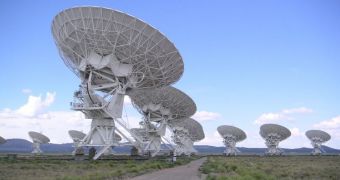This Saturday, on March 31, officials gathered in New Mexico, the United States, and witnessed the renaming ceremony for the iconic Very Large Array (VLA), the largest radio observatory in the world.
The installation has now been named after the founder of radio astronomy, and is known officially as the Karl G. Jansky Very Large Array. This ceremony also marks a series of improvements that were brought to the 27-antenna telescope.
Each of these antennas has a diameter of 25 meters (82 feet), and weighs in excess of 209 metric tons. All the instruments are placed in an Y-shaped pattern, with each of the three arms in the structure connected to the others with a railroad.
This enables astronomers to physically rearrange the locations of each antenna, so that they can obtain aperture synthesis interferometry with a maximum baseline of 36 kilometers (22 miles). This means that the VLA acts as if it had a single, large mirror with this diameter.
In turn, interferometry allows scientists to conduct complex observations of distant targets. This technique is one of the reasons the radio astronomy facility is so renowned, and one of the leading installations studying complex structures, such as magnetic filaments, black holes and young stars.
“Just as Karl Jansky's groundbreaking discovery of cosmic radio waves in 1932 opened a new era of scientific discovery, the vastly improved capabilities of this telescope will give scientists new ways of tackling the challenges facing 21st-century astrophysics,” Fred K.Y. Lo explains.
The expert holds an appointment as the director of the US National Radio Astronomy Observatory (NRAO). The Karl G. Jansky Very Large Array, which was inaugurated in 1980, is a part of the organization, Space Ref reports.
“The Jansky VLA of today is, in some ways, thousands of times more powerful than the VLA of yesterday,” adds the NRAO assistant director for New Mexico operations, Dale Frail.
“It already has produced scientific discoveries that were not possible before. Over the coming years, we will see an impressive flow of new discoveries made possible by the efforts of many very talented and dedicated people,” he goes on to say.

 14 DAY TRIAL //
14 DAY TRIAL //